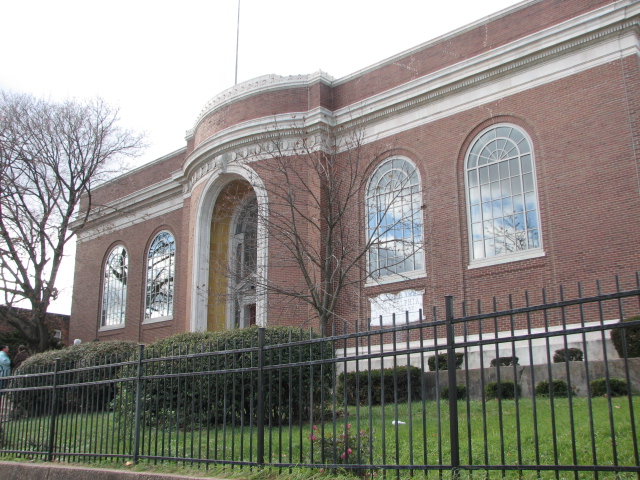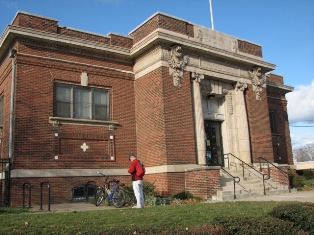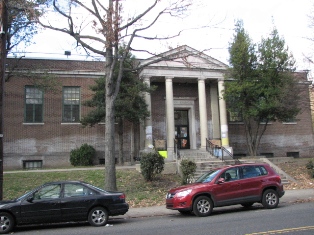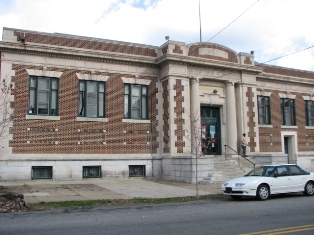Libraries at risk

Haddington branch
Nov. 25
New series casts light on historic and unique sites that may be at risk of deterioration or demolition.
By Alan Jaffe
For PlanPhilly
When Mayor Nutter announced plans to close 11 branches of the Free Library earlier this month as part of his effort to deal with a $1 billion budget deficit, the communities around the targeted sites erupted in protest.
The historic preservation community also fears the loss of a handful of significant buildings in the cutback process.
Four of the 11 threatened branches were the result of the Carnegie Library project, a vital chapter in the history of free access to library resources in America.
From 1886 to 1917, steel magnate Andrew Carnegie provided $40 million for the construction of 1,600 libraries throughout the country, motivated by his belief that the wealthy are obligated to give back to society, according to the research of Catherine Lavoie, chief of the Historic American Buildings Survey (HABS), the federal government’s oldest preservation program. Libraries previously had been available by subscription only, and therefore the domain of the well-to-do.
Philadelphia was home to the first private, subscription library in the U.S., the Library Company founded in 1731, and the American Library Association formed in 1876. The Free Library was established here in 1891 and moved into its home on the Ben Franklin Parkway in 1927. Its branches were located in old mansions, storefronts and the back rooms of commercial buildings. So Philadelphia was a likely candidate for Carnegie’s largesse.
While he paid for 66 branches in New York City, Carnegie funded the next highest number of libraries, 25, in Philadelphia between 1905 and 1930.
Lavoie, an expert on vernacular architecture, traveled with a colleague throughout Philadelphia in 2007 to examine and collect data on the city’s 20 surviving Carnegie libraries.
The four survivors that now face city closure are the Holmesburg, Logan, Kingsessing and Haddington branches.
In Philadelphia, Carnegie’s administrators allowed the librarians themselves to plan the form of the building in line with its functions, but the city’s best-known architects of the era were sought for the design and construction, Lavoie explained. “So each has its own distinct qualities and history.”

The Holmesburg Library, 7810 Frankford Ave., which opened in 1907, was designed by Sterns and Castor, who were known for their commercial, industrial and medical buildings. It was built in accordance with the Carnegie prototype: a small rectangular building with a main floor devoted to the bookshelves and reading space, and a basement for the lecture room. Most of the buildings in Philadelphia also took on characteristics of the popular Beaux Arts style.

The Logan branch, 1333 Wagner Ave., opened in 1918, and because of budget cutbacks of that era was a relatively “stripped down,” functional structure, Lavoie said, although it boasts a formal portico. “It represents the quintessential Carnegie library in Philadelphia.”

The Kingsessing branch, 1201 S. 51st St., opened in 1919 and was designed by Phillip Johnson, who was employed by the city’s Health Department and was known for his hospitals, firehouses, police stations and armories.
“The most exceptional Carnegie library in Philadelphia is the Haddington branch,” Lavoie said. Designed by Albert Kelsey and Paul Cret, the building at 446 N. 65th St., has elaborate, multi-colored terra cotta work that includes a frieze with cartouches of old printers marks. The Haddington Library opened in 1915.
Two of the city’s Carnegie libraries, those in Southwark and Germantown, have found new life as civic or senior citizen centers. The remaining four libraries are still in very good, well-maintained condition, Lavoie said, thanks to their communities and the city.
Lavoie hopes Philadelphia will find new uses for any of the neighborhood libraries that are shut down.
“Carnegie was responsible for taking library services out of the hands of philanthropists and putting them into the hands of municipal governments,” she explained. “It became a civic duty to provide library services.”
Contact the reporter at alanjaffe@mac.com
Previous stories:
WHYY is your source for fact-based, in-depth journalism and information. As a nonprofit organization, we rely on financial support from readers like you. Please give today.



